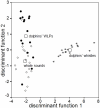Do dolphins rehearse show-stimuli when at rest? Delayed matching of auditory memory
- PMID: 22232611
- PMCID: PMC3247700
- DOI: 10.3389/fpsyg.2011.00386
Do dolphins rehearse show-stimuli when at rest? Delayed matching of auditory memory
Abstract
The mechanisms underlying vocal mimicry in animals remain an open question. Delphinidae are able to copy sounds from their environment that are not produced by conspecifics. Usually, these mimicries occur associated with the context in which they were learned. No reports address the question of separation between auditory memory formation and spontaneous vocal copying although the sensory and motor phases of vocal learning are separated in a variety of songbirds. Here we show that captive bottlenose dolphins produce, during their nighttime resting periods, non-dolphin sounds that they heard during performance shows. Generally, in the middle of the night, these animals produced vocal copies of whale sounds that had been broadcast during daily public shows. As their life history was fully known, we know that these captive dolphins had never had the opportunity to hear whale sounds before then. Moreover, recordings made before the whale sounds started being broadcast revealed that they had never emitted such sounds before. This is to our knowledge the first evidence for a separation between formation of auditory memories and the process of learning to produce calls that match these memories in a marine mammal. One hypothesis is that dolphins may rehearse some special events heard during the daytime and that they then express vocally what could be conceived as a more global memory. These results open the way for broader views on how animals might rehearse life events while resting or maybe dreaming.
Keywords: auditory memory processes; cetacean acoustic plasticity; interspecific vocal copying; sensory–motor-phases separation.
Figures



Similar articles
-
Vocal copying of individually distinctive signature whistles in bottlenose dolphins.Proc Biol Sci. 2013 Feb 20;280(1757):20130053. doi: 10.1098/rspb.2013.0053. Print 2013 Apr 22. Proc Biol Sci. 2013. PMID: 23427174 Free PMC article.
-
A beluga whale socialized with bottlenose dolphins imitates their whistles.Anim Cogn. 2017 Nov;20(6):1153-1160. doi: 10.1007/s10071-017-1132-4. Epub 2017 Sep 27. Anim Cogn. 2017. PMID: 28956181
-
Differences in acoustic features of vocalizations produced by killer whales cross-socialized with bottlenose dolphins.J Acoust Soc Am. 2014 Oct;136(4):1990-2002. doi: 10.1121/1.4893906. J Acoust Soc Am. 2014. PMID: 25324098
-
Auditory signal processing in communication: perception and performance of vocal sounds.Hear Res. 2013 Nov;305:144-55. doi: 10.1016/j.heares.2013.06.007. Epub 2013 Jul 1. Hear Res. 2013. PMID: 23827717 Free PMC article. Review.
-
A blueprint for vocal learning: auditory predispositions from brains to genomes.Biol Lett. 2015 Aug;11(8):20150155. doi: 10.1098/rsbl.2015.0155. Biol Lett. 2015. PMID: 26246333 Free PMC article. Review.
Cited by
-
Social bonding drives vocal exchanges in Bonobos.Sci Rep. 2019 Jan 24;9(1):711. doi: 10.1038/s41598-018-36024-9. Sci Rep. 2019. PMID: 30679444 Free PMC article.
-
Snort acoustic structure codes for positive emotions in horses.Naturwissenschaften. 2018 Sep 12;105(9-10):57. doi: 10.1007/s00114-018-1582-9. Naturwissenschaften. 2018. PMID: 30291452
-
Evidence for Teaching in an Australian Songbird.Front Psychol. 2021 Feb 22;12:593532. doi: 10.3389/fpsyg.2021.593532. eCollection 2021. Front Psychol. 2021. PMID: 33692717 Free PMC article.
-
Captive Bottlenose Dolphins Do Discriminate Human-Made Sounds Both Underwater and in the Air.Front Psychol. 2018 Jan 31;9:55. doi: 10.3389/fpsyg.2018.00055. eCollection 2018. Front Psychol. 2018. PMID: 29445350 Free PMC article.
References
-
- Armstrong E. A. (1960). A Study of Bird Song. London: Oxford University Press
-
- Connor R. C., Smolker R. A. (1996). ‘Pop’ goes the dolphin: a vocalization male bottlenose dolphins produce during consortships. Behaviour 133, 643–66210.1163/156853996X00026 - DOI
-
- Cruickshank A. J., Gautier J.-P., Chappuis C. (1993). Vocal mimicry in wild African grey parrots Psittacus erithacus. Ibis 135, 293–29910.1111/j.1474-919X.1993.tb02846.x - DOI
LinkOut - more resources
Full Text Sources
Research Materials

